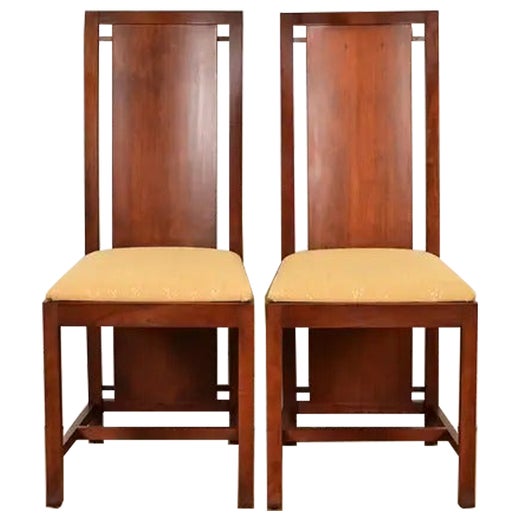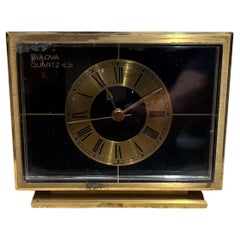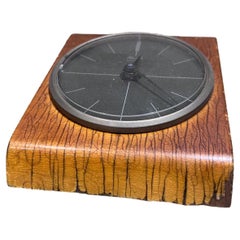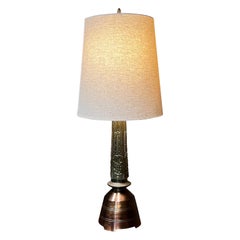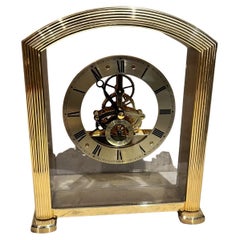Frank Lloyd Wright + Bulova Glass Desk Clock Coonley Playhouse Adaptation
About the Item
- Creator:Bulova Clock Co. (Manufacturer),Frank Lloyd Wright (Designer)
- Dimensions:Height: 5.75 in (14.61 cm)Width: 9 in (22.86 cm)Depth: 2 in (5.08 cm)
- Style:Mid-Century Modern (In the Style Of)
- Materials and Techniques:
- Place of Origin:
- Period:1990-1999
- Date of Manufacture:1990s
- Condition:Wear consistent with age and use. Tested and working, original vintage preowned unrestored condition.
- Seller Location:Chula Vista, CA
- Reference Number:Seller: ACCG10232231stDibs: LU971530983062
Frank Lloyd Wright
Without question the greatest architect the United States has ever produced, Frank Lloyd Wright and his philosophy of “organic architecture” — of buildings that exist in harmony with their natural surroundings — had a profound influence on the shape of modern life.
Wright gave us some of the most elegant and iconic buildings in America: residences such as Fallingwater, in rural Pennsylvania, the Robie House in Chicago, and Taliesin, Wright’s own home; and masterful institutional structures that include the Unity Temple in Oak Park, Illinois, the Johnson Wax headquarters in Racine, Wisconsin, and the Guggenheim Museum in New York. Whenever possible, Wright designed the furniture for his projects, to ensure an affinity between a building’s exterior and interior.
Wright’s wooden chairs and tables for his “Prairie Houses” of the early 1900s have sleek, attenuated forms, influenced by both the simplicity of traditional Japanese design and the work of Gustav Stickley and other designers of the Arts and Crafts movement.
For Taliesin and several residential projects, Wright designed severely geometric chairs that are marvels of reductivist design. He revisited many of these forms in the 1950s in furniture licensed to the North Carolina firm Henredon, adding a decorative frieze-like element to the edges of tables and stools. Owing to a cross-licensing agreement between Henredon and Heritage at the time, Wright's lines of the era are usually labeled Heritage-Henredon.
The works on 1stDibs also show how happily Wright embraced new forms and materials. His desks and chairs for Johnson Wax have a streamlined look and use tubular steel to the same effect as designer Warren McArthur, who collaborated with Wright in the interiors of the Arizona Biltmore Hotel. For the Price Tower (1956) in Oklahoma, Wright designed angular wooden desks as well as upholstered pedestal chairs made of chromed steel — audacious furniture for his tallest completed building project.
The beauty of Frank Lloyd Wright’s furniture designs is that while many of us wish we could live in one of his houses, his vintage sofas, storage cabinets and armchairs connect us directly to his architecture, and to the history he made.
You May Also Like
Late 20th Century Japanese Modern Table Clocks and Desk Clocks
Brass
Vintage 1950s American Decorative Baskets
Mahogany
Late 20th Century American Vases
Ceramic
Vintage 1970s Mexican Mid-Century Modern Table Clocks and Desk Clocks
Glass
Mid-20th Century American Prairie School Decorative Bowls
Wood
Vintage 1950s American Modern Planters, Cachepots and Jardinières
Copper
Mid-20th Century Austrian Mid-Century Modern Table Clocks and Desk Clocks
Crystal, Steel
Vintage 1950s Swiss Mid-Century Modern Table Clocks and Desk Clocks
Metal
20th Century American Post-Modern Table Clocks and Desk Clocks
Glass
Early 20th Century French Table Clocks and Desk Clocks
Oak
More From This Seller
View AllLate 20th Century German Mid-Century Modern Table Clocks and Desk Clocks
Metal, Brass
Vintage 1960s German Mid-Century Modern Table Clocks and Desk Clocks
Metal
Vintage 1950s Mid-Century Modern Table Lamps
Brass
Vintage 1980s Japanese Modern Table Clocks and Desk Clocks
Brass
Mid-20th Century German Art Deco Table Clocks and Desk Clocks
Metal, Brass
Vintage 1960s American Mid-Century Modern Wall Clocks
Aluminum
